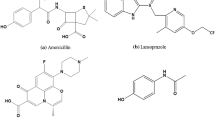Abstract
A sensitive high performance liquid chromatographic method has been developed and validated for the determination of proparacaine in human aqueous humour. The procedure involved extraction of proparacaine from aqueous humour with cyclohexane. The separation was achieved using a Bondesil C8 (250 × 4.6 mm i.d., particle size 5 μm) analytical column with a mobile phase consisted of acetonitrile and sodium dihydrogen phosphate (pH 3.0, 20 mM) (30:70, v/v). Proparacaine and lidocaine (internal standard, IS) detection was performed by UV–Vis detector at 220 nm. The retention times for proparacaine and IS were 12.01 and 5.58 min, respectively. HPLC–UV–Vis method was linear in the range of 75–4,000 ng mL−1. The limit of detection (LOD) was 25 ng mL−1 and the limit of quantification (LOQ) of proparacaine was found to be 75 ng mL−1 (RSD ≤ 15%, n = 6). In intra- and inter-day precision and accuracy analysis, the relative standard deviation was found to be in the range of 0.96 and 7.98%, the bias values were 0.64 and 3.33%. Recovery of proparacaine from human aqueous humour was 99.98% at 500 ng mL−1. Proparacaine solutions were stable at least 6 months at +4 and −20 °C. Proparacaine levels of aqueous humour in fifteen volunteers’ were in the range of 80.21 and 459.00 ng mL−1. According to system suitability tests and Shewhart’s quality control charts the proparacaine responses were in the acceptance ranges. Developed method was providing a sufficient quality at least over 3 months for determination of proparacaine in human aqueous humour.




Similar content being viewed by others
References
Weiss J, Goren MB (1991) Am J Opthalmol 112:326–330
Adriani J, Beuttler WA, Brihmadesam L, Naraghi M (1985) South Med J 78(10):1224–1229
Grant RL, Acosta D (1994) Exp Eye Res 58:469–478
Koehler A, Oertel R, Kirch W (2005) J Chromatogr A 1088(1–2):126–130
Lagnado R, Tan J, Cole R, Sampath R (2003) J Cataract Refract Surg 29(9):1767–1770
Baniceru M, Croitoru O, Popescu SM (2004) J Pharm Biomed Anal 35(3):593–598
Hartmann C, Smeyers-Verbeke J, Massart DL, McDowall RD (1998) J Pharm Biomed Anal 17:193–218
ICH, (2005) Harmonized Tripartite Guideline, Validation of analytical procedures: text and methodology Q2 (R1), ICH Steering Committee
Eurochem (1998) The fitness for purpose of analytical methods, a laboratory guide to method validation and related topics, United Kingdom
Causon R (1997) J Chromatogr B 689:175–180
Braggio S, Barnaby RJ, Grossi P, Cugola M (1996) J Pharm Biomed Anal 14:375–388
Basci NE, Temizer A, Bozkurt A, Isimer A (1998) J Pharm Biomed Anal 18:745–750
Jiménez C, Ventura R, de la Torre X, Segura J (2002) Anal Chim Acta 460:289–307
Acknowledgements
This study was partially supported by Hacettepe University Research Fund grant (03D05301001).
Author information
Authors and Affiliations
Corresponding author
Additional information
Application of Separation Techniques in Turkey.
Rights and permissions
About this article
Cite this article
Dincel, A., Basci, N.E., Atilla, H. et al. Development and Validation of an HPLC–UV–Vis Method for the Determination of Proparacaine in Human Aqueous Humour. Chroma 66 (Suppl 1), 51–56 (2007). https://doi.org/10.1365/s10337-007-0266-y
Received:
Revised:
Accepted:
Published:
Issue Date:
DOI: https://doi.org/10.1365/s10337-007-0266-y



